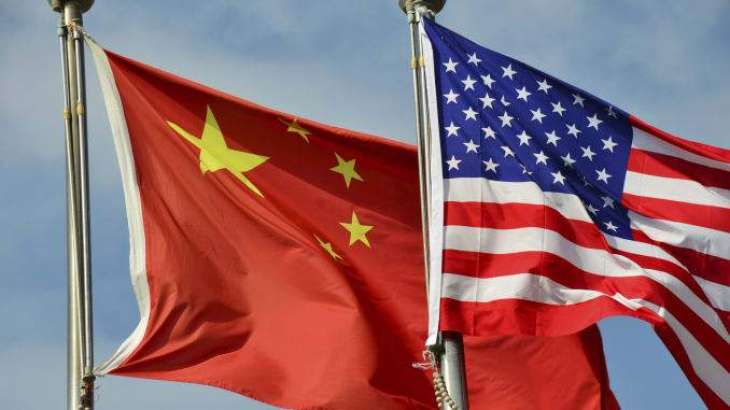The banking industries of the United States and China, the two largest global economies, which are currently embroiled in a trade dispute, will make it through the COVID-19-induced crisis despite a huge slump in profits, analysts told Sputnik
MOSCOW (Pakistan Point News / Sputnik - 08th September, 2020) The banking industries of the United States and China, the two largest global economies, which are currently embroiled in a trade dispute, will make it through the COVID-19-induced crisis despite a huge slump in profits, analysts told Sputnik.
Last week, four of China's largest banks reported a double-digit percentage fall in profits in the first half of 2020 year-on-year amid the ongoing COVID-19 pandemic. The Industrial & Commercial Bank of China Ltd., the world's largest lender in terms of assets, saw its net profit fall by 11.4 percent to 148.8 billion yuan ($21.7 billion) in the first half of 2020. China Construction Bank Corp., Agricultural Bank of China Ltd. and Bank of China Ltd. all posted a drop in profits ranging from 10.3 percent to 11.5 percent year-on-year.
Meanwhile, the US Federal Deposit Insurance Corp. said in late August that the US banking industry's second-quarter profits declined by 70 percent year-on-year, from $62.5 billion to $18.8 billion. However, the US deposit insurance agency said that it did not see any systemic problems for the national banking sector, as the banks took in record deposits in the second quarter.
BANKS WELL-CAPITALIZED TO WEATHER DOWNTURN
The US banking sector seems well-prepared by now to sustain losses in profits, as it had amassed a sufficient rainy day fund, Mo Chaudhury, the associate professor of finance with the Desautels Faculty of Management at McGill University, told Sputnik.
"I tend to agree that the systemic risk in the overall US Banking System is negligible at this time. Most large banks are well-capitalized. Further, the Federal Reserve has injected trillions of dollars of liquidity during the last few months through various facilities including purchases of Mortgage Agency securities and investment-grade corporate bond ETFs. This has lowered credit risk premium across the board including that on high yield (low quality), and on top of that the Federal Funds Rate has been cut to close to zero," Chaudhury said.
The US financial institutions and businesses have already managed to raise new funds and refinance maturing loans, avoiding financial distress in the COVID-19 reality, the professor noted.
"In the meantime, the large banks have literally printed money from underwriting fees related to massive bond/loan issuances and surging trading volume in financial markets. With rising profits, they have provisioned large sums for potential loan losses that may ensue later if the economic downturn continues or gets worse. Overall, there are no signs of any stress in the US banking system," Chaudhury added.
The largest Chinese banks, such as the Bank of China, can afford to lower its profit margin and instead need to redirect profits to supporting the real sector of the economy, Bian Yongzu, an expert at the Chongyang Institute of Financial Studies at the Renmin University of China, told Sputnik.
"Bank of China's profit has declined but remains quite high. In the first half of the year, the profit of the five largest banks in China amounted to 500 billion yuan or more than 2 billion per day. This is a high indicator, profit can be further reduced, it should be transferred to the real sector of the economy," Bian said.
Vanessa Rossi, an expert in international economics and finance with the Oxford Analytica company, agrees with Bian on the resilience of the Chinese banking sector.
"China has had banking crises before and the system has nevertheless survived. One day, there will be a crisis that generates far greater turmoil but it is not yet inevitable ... China's economy appears to be coping relatively well albeit it has seen losses. The second problem is not yet as easy to assess but we may guess that provided the economy can move ahead, and the government is prepared to help the banking system if necessary, then tensions can be contained," Rossi told Sputnik.
COVID-19 SECOND WAVE RISKS REMAIN
Even though the experts have agreed that both the US and Chinese banking sectors will manage to survive the hard times, risks for the industry remain in light of a possible second wave of the COVID-19 pandemic and the return of large-scale lockdown measures.
"A key risk is a resurgence of COVID in the fall that may lead to lockdowns and loss of consumer and business confidence. The US consumers and the service sector are the largest chunks of the US economy and both would be in even greater peril compared to now. Another significant risk is the possibility of housing prices reversing the counterintuitive rise in prices during the most severe economic circumstances since the Great Depression of the 1930s. A reversal is quite likely if the employment circumstances do not improve materially in the coming months," Chaudhury said.
The upcoming US presidential election and possible complications with the transfer of power if incumbent US President Donald Trump loses the race may also pressure the financial market, which is currently in a state of euphoria despite the woes of the real economy, the McGill professor added.
Even though large US banks and financial institutions are safe, smaller banks could be in danger, according to the expert.
"The smaller regional and monoline financial institutions may have trouble if the economic downturn continues or worsens and the tens of millions of people remain unemployed. Their main assets, namely loans to local small businesses and residents, may become/remain nonperforming for an extended period of time. Given their local deposit base (which was temporarily boosted by Us Government fiscal stimulus in the form of payments to individuals and loans to businesses via Payroll Protection Program), they may have trouble retaining sufficient deposits at a time of increasingly nonperforming loans," Chaudhury noted.
As for China, the significant reduction of capital expenditure by the international businesses, as well as the diminishing investment flow, cast a shadow over the country's financial sector, according to Rossi.
"The biggest threat is one of accelerating losses in capital flows, reflecting a deep-seated change in view of the medium to long-term investment opportunities in China. This would also destabilize the exchange rate. So far, there have been no signs of such capital flight. In fact, the Yuan has strengthened against the weakening dollar and is currently trading at the top end of its trading range over the last couple of years. This may be as much due to US uncertainty as China's strength but nevertheless, it suggests less reason to fear that a financial crisis is imminent in China," the Oxford Analytica expert concluded.




